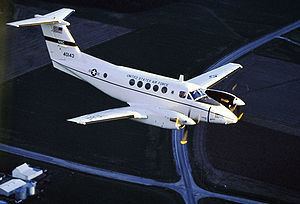Top speed 536 km/h Length 13 m Engine type Turboprop | Wingspan 17 m Unit cost 6,000,000–6,000,000 USD Manufacturer Beechcraft | |
 | ||
Usaf s beechcraft c 12 huron takes off and landing
The C-12 Huron is the military designation for a series of twin-engine turboprop aircraft based on the Beechcraft Super King Air and Beechcraft 1900. C-12 variants are used by the United States Air Force, United States Army, United States Navy and United States Marine Corps. These aircraft are used for various duties, including embassy support, medical evacuation, as well as passenger and light cargo transport. Some aircraft are modified with surveillance systems for various missions, including the Cefly Lancer, Guardrail and Project Liberty programs.
Contents
- Usaf s beechcraft c 12 huron takes off and landing
- Beechcraft c 12 huron
- Design and development
- C 12J
- King Air 200 based variants
- King Air 350 based variants
- Beechcraft 1900 based variant
- Operators
- Specifications Beechcraft C 12 Huron
- References

Beechcraft c 12 huron
Design and development

The first C-12A models entered service with the U.S. Army in 1974 and were used as a liaison and general personnel transport. The aircraft was essentially an "off-the-shelf" Super King Air 200, powered by the type's standard Pratt & Whitney Canada PT6A-41 engines.

The U.S. Navy followed suit in 1979, ordering a version of the Super King Air A200C (modified with a 52 inch by 52 inch cargo door from the Super King Air 200C), designating it the UC-12B, for logistics support between Naval and Marine Corps air stations, air facilities, and other activities, both in CONUS and overseas. The cabin can readily accommodate cargo, passengers or both. It is also equipped to accept litter patients in medical evacuation missions. Through 1982, the Navy ordered 64 of these aircraft.
A U.S. Air Force variant of the plane for surveillance roles primarily over Afghanistan and Iraq was the MC-12W Liberty. For that variant, Beechcraft built the basic plane and then sent it to Greenville, Texas where sophisticated intelligence, surveillance and reconnaissance (ISR) equipment was installed by L-3 Communications Missions Integration. As of 2013 the Liberty program had exceeded 300,000 combat flying hours. The MC-12W was rushed into combat as a supplemental surveillance and signals intelligence asset; since its first combat mission on 10 June 2009, the aircraft flew 400,000 combat hours in 79,000 combat sorties, aiding in the kill or capture of “more than 8,000 terrorists” and uncovering 650 weapons caches. With its roles taken over by the growing MQ-9 Reaper fleet, the Air Force decided to divest itself of the 41 Liberty aircraft and turn them over to the U.S. Army and U.S. Special Operations Command, which was completed by October 2015. The Air Force's final MC-12W deployment in support of Operation Enduring Freedom ended on 13 October 2015.
C-12J
To meet the needs of transporting larger groups, the U.S. Army purchased six C-12J aircraft, based on the Beechcraft 1900C commuter airliner. One of the military C-12Js is used for GPS jamming tests at the 586th Flight Test Squadron, Holloman Air Force Base, New Mexico. Another is based at the 517th Airlift Squadron, Elmendorf Air Force Base, Alaska. Three were based at the 55th Airlift Flight, Osan Air Base, South Korea. They have been relocated to the 459th Airlift Squadron, Yokota Air Base, Japan. The remaining two are used by U.S. Army Aviation.
Although the UD- series 1900s were manufactured exclusively for military use, the United States military and other military and government organizations use 1900s from other series such as the UB-series 1900C, and 1900Ds which may be found elsewhere.
King Air 200-based variants
King Air 350-based variants
Beechcraft 1900-based variant
The Air Force currently operates only 4 C-12Js. 3 are operated by the 459th Airlift Squadron at Yokota Air Base, Japan and 1 by the Air Force Materiel Command from Holloman AFB, New Mexico. The Army has C-12Js in use.
Note: The U.S. military also operates other King Air versions under other designations, including the C-6 Ute and T-44 series. In addition, there are a number of Beechcraft 1900s operated by the military under civilian registrations, using their civilian model designations.
Operators
Specifications (Beechcraft C-12 Huron)
Data from Jane's
General characteristics
Performance
